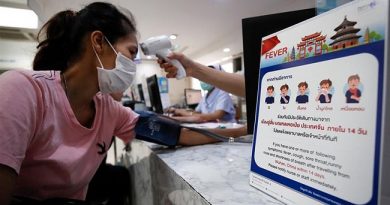Tackling Northeast Malnutrition through Improved Funding
In order to cushion the effects of malnutrition in the North-east, the Department For International Development in collaboration with the United Nations Children’s Fund, as well as Borno and Yobe State governments have contributed the sum of N18.5 billion for the purchase of Ready to Use Therapeutic Food, Michael Olugbode and Kuni Tyessi report
The North-eastern region of Nigeria comprises six states namely Borno, Adamawa, Yobe, Gombe, Taraba and Bauchi.
While the last aforementioned three have enjoyed relative peace after countable and spasmodic episodes of insurgency, the first three have been embroiled, until of recent in severe attacks, which has resulted in several negative effects and with malnutrition in the front burner.
Conflict is part of human existence due to different ideologies, beliefs and outlook towards life which is usually hinged on interest.
Consequences of Conflict
However, the attendant consequences are usually not bargained for, neither are they part of issues discussed or envisaged.
The outcome which usually leaves a sour taste and a protracted tale of regrets, are felt by children who are always the primary victims of every civil unrest.
Abdulkareem Haruna and Michael Olugbode of Premium Times and THISDAY newspaper respectively, had during a two-day media dialogue in Maiduguri, the Borno State capital, giving a pictorial scenario of the lives of several children, particularly in some areas of the state in which no fewer than 10 new reported cases of malnutrition are recorded each day.
The mothers were seen feeding their children with Ready to Use Therapeutic Food (RUTF) which is a blend of soy beans, groundnuts and other condiments which are rich in iron, protein and calcium, among others.
The RUTF which also serves as supplements and not meant for all children were given specifically to children who had been malnourished as a result of years of insurgency.
Besides malnutrition which can translate to Severe Acute Malnutrition (SAM), cases of stunted growth and wasting as a result of lack of food, or its availability, or inability to be served in the correct proportion is an occurrence which is practiced by mothers who are ignorant to the basic needs of children at their formative years, which is usually between the ages of zero to five.
Therefore, it is not unusual to see children with thin skin which barely covers their frail bones looking sickly, and are exposed to energy loses which leads to poor and low productivity in adult life, increased poverty level, as well as compromised immunity in the face of disability and other diseases.
It has been reported that there are more than one 1.4 million children at risk of death. A total of 20 million people, mainly concentrated in Yemen, Somalia, South Sudan and Nigeria, are facing a very serious humanitarian emergency.
The population is worn down by armed conflict and drought, and malnutrition has become the real health emergency, mainly affecting the most vulnerable people, such as pregnant women and children.
In cases of crises and wars, families are debarred from cultivating their land, abandon or sell their livestock, and are looking for somewhere safe to live, this place most times are in displaced persons camp, and it comes with a bagful of many health and sanitation challenges.
This is the case with Nigeria’s North-east where about two million people, are said to be, displaced by the Boko Haram crisis.
Malnutrition
Malnutrition, is said to be a silent war that takes more victims than armed wars. A recent report claims that an estimated 2.5 million boys and girls under the age of five suffer from Severe Acute Malnutrition (SAM) every year in Nigeria.
According to Nutrition Sector annual projections, an estimated 371,000 boys and girls under the age of five in Borno, Adamawa and Yobe (BAY) states will suffer from Severe Acute Malnutrition (SAM), a life- threatening condition.
In North-east Nigeria, the nutrition surveillance data also showed slight improvement on the nutrition situation since the beginning of the response led by United Nations Children’s Fund (UNICEF) and majorly supported by Department For International Development (DFID).
The impact could have been much more but for the wide-spread insecurity, population displacement, poor food security situation, sub-optimal water, hygiene and sanitation practices and high disease burden which continued to strain the on-going efforts to curb malnutrition in all its forms in the region.
Interventions
However, with the intervention of the DFID with the sum of N18.5 billion, children suffering from SAM and who are four to 11 times more likely to die compared to their healthy counterparts can be given another chance to live healthy lives and attain their peak in adulthood.
The United Nations Children’s Fund (UNICEF), with the funding from DFID is implementing two multisectoral projects to promote positive nutrition outcomes in the North-east. These are the Flexible Integrated and Timely (FIT) Project in Borno State and Working to Improve Nutrition in Northern Nigeria (WINNN) project in Yobe State.
The FIT project started in April 2019 and will run through March 2022 with a budget of 36 million pounds, whilst the WINNN project began in April 2019 and will end in March 2020 with a budget of five million pounds. Both projects entail provision of a basic package of nutrition services.
UNICEF Nutrition Specialist in Maiduguri, Ms. Abigail Nyukuri in her speech at the programme themed “Integrated and timely response to nutrition-related humanitarian needs”, revealed that cases of malnutrition in the Northeast were still at an emergency level in Borno, Adamawa and Yobe states and with the percentages pegged at 11 per cent, six per cent and 13 per cent respectively.
She added that, “an estimated 2.5 million boys and girls under the age of five suffer from SAM every year in Nigeria and this condition causes irreversible brain damage and compromised intellectual capacity in adulthood, leading to reduced productivity and an estimated 16 per cent loss in the Growth Domestic Product (GDP) of the economy.”
Also, according to nutrition sector annual projections of UNICEF, an estimated 371,000 boys and girls under the ages of five in Borno, Adamawa and Yobe states will suffer from SAM.
“In Northeast Nigeria, the nutrition surveillance data indicate slight improvement on the nutrition situation since the beginning of the response.
However, the wide-spread insecurity, population displacement, poor food security situation, sub-optimal water, hygiene and sanitation practices and high disease burden continue to strain the on-going efforts to curb malnutrition in all its forms in the region.”
Latest nutrition survey as disclosed by UNICEF, states that the prevalence of Global Acute Malnutrition (GAM) among boys and girls aged below five years is 11 per cent in Borno, 13per cent in Yobe and six per cent in Adamawa, indicating very high levels of malnutrition according to World Health Organisation (WHO) classification.
“The protracted access constraints has made the situation even worse in Rann (Kala Balge), South Yobe, Magumeri, Jere and Konduga Local Government Areas.
If not timely identified and treated, malnutrition has serious and permanent consequences in the growth and development of children,” she said.
To date, through the FIT and WINNN projects, UNICEF has been able to treat 165,000 children suffering from SAM using RUTF, provide micro-nutrient supplementation to 135,000 children aged six-23 months and 550,000 pregnant and lactating women were given skilled infant and young child feeding in emergencies.
The fund, being the sole pipeline agency for RUTF for the collective response, against the projected figures, has funds for 29,314 cartons of RUTF, leaving a funding gap of N4.4 billion for the procurement of 229,636 cartons of RUTF, according to UNICEF.
UNICEF also noted the tremendous improvement so far being recorded as a result of DFID intervention.
Hopefully, with more and consolidated efforts already being made, it will not be negative news all the way.




